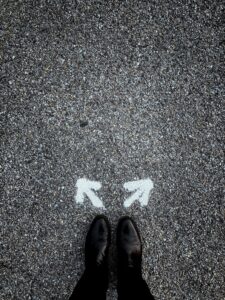Beyond Binary Thinking to “Yes, and”
Science, reason, and freethinking are highly valued by humanists and often are the focus of our communities’ writings and presentations. They’re how we make sense of and find meaning in a complicated world full of growing information. Processing this information through research, experimentation, and discussion requires constant practice and reflection. Critical Thinking—one of the American Humanist Association’s Ten Commitments—recognizes that:
Exercising our minds to build these skills enables us to challenge biases in ourselves and in others, paving the way for a fair, open-minded, and autonomous perspective that fosters a multicultural worldview.
Expanding our minds is essential to getting out of the harmful dualistic perspective that reduces concepts to a binary: either/or, yes/no, good/evil, right/wrong, us/them. This over-simplification of the world constrains our thinking and distracts us with conflict instead of guiding us to solutions. When we limit our options, we miss out on opportunities to learn from other perspectives and explore alternatives and combinations that might be more useful. Recognizing there are several factors to societal problems that require different tactics will remind us of the importance of working collaboratively and simultaneously. Acknowledging that people hold multiple identities—both obvious and private, permanent and fluid—that make us unique and connected will help us empathize with and support each other, improving society for all.
Humanism is an ever-evolving lifestance “guided by reason, inspired by compassion, and informed by experience.” We gather and use information in many ways to “aspire to the greater good of humanity.” Humanism is more than just advocating for science and rejecting supernaturalism. It’s also about actively caring for other beings and our planet, combatting oppressive societal systems, and developing as an individual. In other words, “yes, and”.
In improvisation, actors practice the “yes, and” technique to help keep a scene going together. “Yes” acknowledges the contribution of the previous person while “and” provides an opportunity for the next person to add to the scene. For example, one may say, “I’m making a cake” while pantomiming mixing ingredients together. The next person could say, “yes, and I will add the sprinkles” or “yes, and I will eat the cake.” If the second person instead said, “no, you’re turning a crank” or “no, you’re stupid, you’re just moving your arms around,” that would reject the first presented scenario, hurt the actors involved, and disrupt or end the scene. To keep the game going, people can redirect scenes, introduce and remove characters, re-imagine spaces, and come to a comfortable close. The shared goal is to develop an entertaining scene that incorporates the audience’s ideas and the actors’ talents.
We can apply the “yes, and” practice to a conversation where all parties are welcome to contribute information, ideas, and questions. You can show you’re listening and adding to the previous speaker by starting with “yes, and” or “bouncing off of what you said” or “echoing that idea”. If you want to share an alternative idea or take the discussion in a different direction, you can start by acknowledging the previous person and finding common ground before you add your part. This builds trust that you’re joining others in discussion and invites them to consider your contributions, too. Sometimes we use “yes, but” when we’re not really opposing the original idea, merely adding another concept. Replacing “but” with “and” could make your addition more welcoming. For example, in response to someone saying we just need to vote, you could say “yes, voting is essential, and that’s why we need to remove barriers to voting. And so is education for candidates and constituents. And so is engagement in between elections.” You’re expanding the person’s perspective and noting other intersectional needs.
Binary thinking limits our options and splits the world into opposing sides. Let’s break the binary, come together, expand our opportunities, and open ourselves up to more possibilities.

